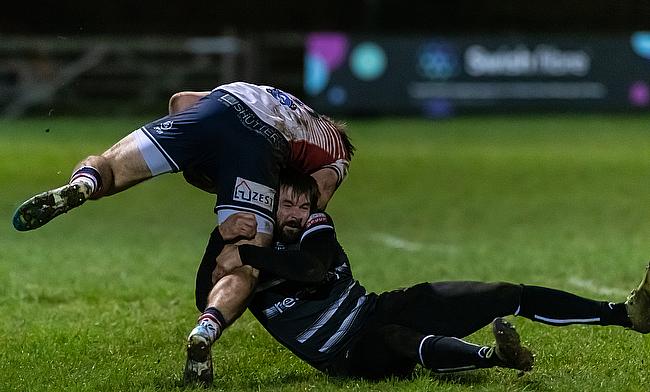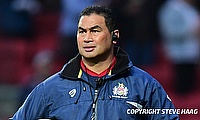RFU announce ‘waist and below’ tackle policy for community game for next season

From the start of next season tackle height has been lowered to below the waist
©David Howlett
In the aim of supporting player welfare, the Rugby Football Union confirmed that the RFU Council had voted to lower the height of the tackle in community rugby, starting in July 2023.
From the new season tackle height has been set at the waist or below, the decision driven by informed data and to reduce head impact exposure and concussion risk.
Evidence from studies in France, South Africa, New Zealand and the RFU’s own trial of the ‘armpit line’ tackle height in the Championship Cup in 2018 was taken into account before the unanimous decision was made.
That RFU study was concluded following the group stages of the Championship Cup, where after 36 matched, there was a 41 per cent decrease in tackles making contact with the head or neck of an upright ball-carrier, but the concussion risk increased when both the tackler and ball-carrier were bent at the waist.
These changes from the RFU see call-carriers encouraged to “follow the principal of evasion”, to “avoid late dipping” with the intention of reducing the chance where a bent tackler has an increased risk of making a head-on-head collision.
In the men’s game, the tackle height change will be introduced from National One and extend to the bottom of the rugby pyramid, while in the women’s came the lowered tackle height is to be implemented from Championship One.
These changes will be seen across clubs, schools, colleges and universities at all levels and programmes to support players, coaches and match officials, including detailed law application guidelines are being developed to ensure players, match officials and volunteers will be ready for next season.
The study in France, where similar changes were implemented in 2019, saw a 63 per cent reduction in head-on-head contacts while also leading to a more fluid game. A radical step by the RFU, the governing body’s chairman, Nigel Gillingham, says that it is the health of the game’s participants which is at the heart of decision making.
“Players’ welfare must always be at the centre of decisions we make about how we play the game of rugby,” Gillingham said. “Evidence from our own research and from around the world clearly shows that lowering the tackle height will reduce impact exposure and the risk of concussion.
“The RFU Council is able to influence how the game is played at the community level in this country and, therefore, has unanimously supported the decision to lower the tackle height to waist level.
“The tackle will remain the primary method of stopping the ball carrier using safe techniques that are taught from an early age.”
In their press release, the RFU said that the “process of developing law variations and the law application guidelines is well underway”. An RFU spokesperson would later confirm that a series of coaching intervention options would be made available to clubs ahead of the new tackle height being implemented.
“A multi-format programme of training and technical support will be put in place for players, coaches and match officials," the RFU spokesperson said. "This will include face-to-face workshops, webinars, e-learning and video guidance. Training will be rolled out from the spring, through the summer and throughout next season. Constituent Body Coaching leads and Referee Societies will be invited to support the scheduling and roll out of this training.
“We understand this is a significant change and the game will have questions around the detail of the new law variation, what it means for coaches and players and how the tackle will be refereed during different phases of the game, for example close to the goal line versus counter attacks in open play.
"Detailed law application guidelines and training materials will be provided over the coming weeks for players, coaches and match officials to give clarity for the game. By making this decision now, the intention is to give the game time to prepare ahead of the new season.”
There was much reaction to this radical change by the game’s governing body. A large majority of people were keen to emphasise that the RFU were widening the gap between the elite and amateur, especially given that National One and National Two is semi-professional in some instances.
Beyond first team rugby, there is the question of what this will mean for the players that lace up their boots at the weekend for the sheer enjoyment of the game. A sport billed as being for everyone, waist and below tackling could well be discouraging for some.
This announcement came on the same day which 55 former amateur players had written to the RFU, World Rugby and Welsh Rugby Union to set out their case before a potential lawsuit.
This claim also involves retired female internationals and male players involved in the game before professionalism was introduced in 1995, while the law firm leading the 55 complainants, Rylands Garth, are hoping to “help make the game safe for future generations”, while also seeking financial compensation.
Words from the writer – Joe Harvey
We will certainly see an adjustment period in the amateur game as people get to grips with these new rules. Since sharing the news of these rules on social media, my mentions have been filled with debate about the various merits of lowering tackle height.
For some time, rugby has been clouded by concerns about its safety. Much of this is to do with brain injuries and the game’s governing bodies are perhaps looking to the long-term with these changes.
With the science referenced by the governing body, if further studies find it to be accurate and be preventative to brain injury, there will be a hope to promote growth of the game at a grassroots level, even if some choose to give up the sport now.
Quite how this will be applied to competitions like BUCS is uncertain too. With that governing body overseeing rugby across the United Kingdom, there is a possibility that teams based in Scotland, Wales and Northern Ireland may well find themselves beholden to the RFU's ruling purely for consistency.
Furthermore, there is an impact to the professional game. With Premiership academies sending developing players on loan to National League Rugby clubs, the future of that could be up for debate also. As a result of a distinct difference in tackling rules, those relationships with clubs in National 1 and cause a significant gap between what has been deemed 'amateur' and 'elite'.
As ever, it is a situation which will develop over the coming weeks and months and rage on well into the new season. Let us know your thoughts in the comments section below.









